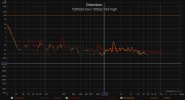- Thread Starter
- #21
Ah, I wasn't even thinking that... I was thinking they would increase power until clipping began and when distortion finally rose to 0.7 or 1% they gave that rating.Generally the difference in power from x% distortion to clipping depends upon how manufacturers rate the amp, what headroom they build into their spec, and how much feedback is present. Then you have to consider if the clipping is short-term or long-term, thermal issues, and so forth. And finally you must decide what "clipping" means to you -- is it when the waveform is completely flat-topped, some high level of distortion, or what? I do not think there can be a simple metric because designs differ greatly, as do specs. One manufacturer may rate distortion low and thus limit their power spec, whilst another may spec higher distortion (closer to clipping) to provide a higher power number. Rated full power does not always correlate to clipping or to headroom.
Clipping is usually estimated by looking at the knee of the distortion curve as power is increased. An amp with low or "no" feedback may have a very "soft" knee, making it hard to draw a line before hard clipping (flat-topped waveforms), and a rather broadly sloped distortion line as it begins to clip. An amp with high feedback will have low distortion until nearly at clipping, resulting in a very sharp knee and almost vertical line. The difference could be several dB as others have said so there is not a simple (linear) ratio for what is fundamentally a very nonlinear operation. Some manufacturers market 6 dB headroom, others almost none, again greatly affecting the power rating "before clipping". Using a single number could greatly over- or underestimate the actual performance.
Yes, some amps use higher rail voltages than the transformer is capable of supporting continuously into 8 or 4 ohms, which, in combination with bulk capacitors, enables louder transients. I thought that even in those cases, when the current capability is maxed there is voltage droop and this is used as the RMS rating when clipping begins
edit: I know it's not just lack of power supply current capability that can induce clipping in those situations, but IME, in all properly designed amplifiers it usually is (as it should be)



